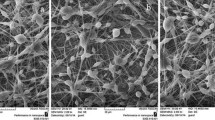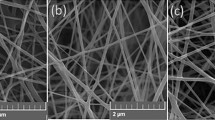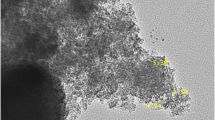Abstract
Although much focus has been placed in the recent years to find new nanofiber-based materials produced by electrospinning medicinal plant extracts, there is no study to determine plant extract-polymer compatibility and matching in terms of antibacterial activity and nanofiber morphology. In this study, we aim to produce nanomats with effective antimicrobial properties by combining the polymers used in the medical field with the extracts obtained from various plants in Turkey via electrospinning technique. In line with this goal, three medicinal natural herbal extracts of Hypericum perforatum (HP), Agrimonia eupatoria (AE) and Satureja hortensis (SH) were used after an intensive analyzing of nine medicinal plants as antibacterial and healing agents from the country flora. Several composite nanofibers have been obtained by electrospinning technique, and the best polymer-extract compatibility with demonstrating 18 and 22 mm inhibition zone against Staphylococcus aureus (S. aureus) and Pseudomonas aeruginosa (P. aeruginosa), respectively, was observed for thermoplastic polyurethane (TPU)/SH composite. Later on, detailed studies of TPU/SH nanofiber were continued. Taken together, antibacterial and morphological properties of the composite nanofibers can be controlled by selecting the polymer and extract types properly for various wound care dressings. Antimicrobial, air permeability, morphological and chemical properties of the obtained composite nanofibers were also analyzed and evaluated.






Similar content being viewed by others
References
Li H, Williams GR, Wu J, Lv Y, Sun X, Wu H, Zhu L-M (2017) Thermosensitive nanofibers loaded with ciprofloxacin as antibacterial wound dressing materials. Int J Pharm 517(1–2):135–147
Global Forecast to 2022, https://www.marketsandmarkets.com/Market-Reports/wound-care-market-371.html. Accessed 16 August 2017
Jin G, Prabhakaran MP, Kai D, Annamalai SK, Arunachalam KD, Ramakrishna S (2013) Tissue engineered plant extracts as nanofibrous wound dressing. Biomaterials 34(3):724–734
Phaechamud T, Issarayungyuen P, Pichayakorn W (2016) Gentamicin sulfate-loaded porous natural rubber films for wound dressing. Int J Biol Macromol 85:634–644
Yousefi I, Pakravan M, Rahimi H, Bahador A, Farshadzadeh Z, Haririan I (2017) An investigation of electrospun Henna leaves extract-loaded chitosan based nanofibrous mats for skin tissue engineering. Mater Sci Eng C 75:433–444
Namazi H, Rakhshaei R, Hamishehkar H, Kafil HS (2016) Antibiotic loaded carboxymethylcellulose/MCM-41 nanocomposite hydrogel films as potential wound dressing. Int J Biol Macromol 85:327–334
Ziemińska E, Strużyńska L (2016) Zinc modulates nanosilver-induced toxicity in primary neuronal cultures. Neurotox Res 29(2):325–343
Wu T, Tang M (2018) Review of the effects of manufactured nanoparticles on mammalian target organs. J Appl Toxicol 38(1):25–40
Panáček A, Kvítek L, Smékalová M, Večeřová R, Kolář M, Röderová M, Dyčka F, Šebela M, Prucek R, Tomanec O (2018) Bacterial resistance to silver nanoparticles and how to overcome it. Nat Nanotechnol 13(1):65
Gao Y, Cranston R (2008) Recent advances in antimicrobial treatments of textiles. Text Res J 78(1):60–72
Hajipour MJ, Fromm KM, Ashkarran AA, de Aberasturi DJ, de Larramendi IR, Rojo T, Serpooshan V, Parak WJ, Mahmoudi M (2012) Antibacterial properties of nanoparticles. Trends Biotechnol 30(10):499–511
Maver T, Maver U, Stana Kleinschek K, Smrke DM, Kreft S (2015) A review of herbal medicines in wound healing. Int J Dermatol 54(7):740–751
Atta-ur-Rahman (2012) Studies in natural products chemistry, vol 36. Elsevier, Amsterdam
Bahramsoltani R, Farzaei MH, Rahimi R (2014) Medicinal plants and their natural components as future drugs for the treatment of burn wounds: an integrative review. Arch Dermatol Res 306(7):601–617
Paul S, Dutta T, Chaudhuri TK, Bhattacharjee S (2017) Curative and protective properties of crude gel of Aloe vera from sub-Himalayan West Bengal in chronic and acute inflammatory rat models
Singh R, De S, Belkheir A (2013) Avena sativa (Oat), a potential neutraceutical and therapeutic agent: an overview. Crit Rev Food Sci Nutr 53(2):126–144
Ude C, Schubert-Zsilavecz M, Wurglics M (2013) Ginkgo biloba extracts: a review of the pharmacokinetics of the active ingredients. Clin Pharmacokinet 52(9):727–749
Osorio-Tobón JF, Carvalho PI, Rostagno MA, Petenate AJ, Meireles MAA (2014) Extraction of curcuminoids from deflavored turmeric (Curcuma longa L.) using pressurized liquids: process integration and economic evaluation. J Supercrit Fluids 95:167–174
Bashir T, Zahara K, Haider S, Tabassum S (2015) Chemistry, pharmacology and ethnomedicinal uses of Helianthus annuus (sunflower): a review. Pure Appl Biol 4(2):226
Barnes J, Anderson LA, Phillipson JD (2001) St John’s wort (Hypericum perforatum L.): a review of its chemistry, pharmacology and clinical properties. J Pharm Pharmacol 53(5):583–600
Avci H, Monticello R, Kotek R (2013) Preparation of antibacterial PVA and PEO nanofibers containing Lawsonia inermis (henna) leaf extracts. J Biomater Sci Polym Ed 24(16):1815–1830
Agarwal P, Alok S, Verma A (2014) An update on ayurvedic herb henna (Lawsonia inermis L.): a review. Int J Pharm Sci Res 5(2):330
Bulle S, Reddyvari H, Nallanchakravarthula V, Vaddi DR (2016) Therapeutic potential of Pterocarpus santalinus L.: an update. Pharmacogn Rev 10(19):43
Gopi K, Renu K, Vishwanath BS, Jayaraman G (2015) Protective effect of Euphorbia hirta and its components against snake venom induced lethality. J Ethnopharmacol 165:180–190
Azis H, Taher M, Ahmed A, Sulaiman W, Susanti D, Chowdhury S, Zakaria Z (2017) In vitro and In vivo wound healing studies of methanolic fraction of Centella asiatica extract. S Afr J Bot 108:163–174
Yu D, Yuan Y, Jiang L, Tai Y, Yang X, Hu F, Xie Z (2013) Anti-inflammatory effects of essential oil in Echinacea purpurea L. Pak J Pharm Sci 26(2):403–408
Su S, Hua Y, Wang Y, Gu W, Zhou W, J-a Duan, Jiang H, Chen T, Tang Y (2012) Evaluation of the anti-inflammatory and analgesic properties of individual and combined extracts from Commiphora myrrha, and Boswellia carterii. J Ethnopharmacol 139(2):649–656
Zhao H, Deneau J, Che GO, Li S, Vagnini F, Azadi P, Sonon R, Ramjit R, Lee SM, Bojanowski K (2012) Angelica sinensis isolate SBD. 4: Composition, gene expression profiling, mechanism of action and effect on wounds, in rats and humans. Eur J Dermatol 22(1):58–67
Fonseca YM, Catini CD, Vicentini FT, Nomizo A, Gerlach RF, Fonseca MJV (2010) Protective effect of Calendula officinalis extract against UVB-induced oxidative stress in skin: evaluation of reduced glutathione levels and matrix metalloproteinase secretion. J Ethnopharmacol 127(3):596–601
Gergeroglu H, Avci H (2017) Functional composite nanofibers derived from natural extract of Satureja hortensis. Anadolu Univ J Sci Technol A Appl Sci Eng 18(5):908–918
Zhang W, Ronca S, Mele E (2017) Electrospun nanofibres containing antimicrobial plant extracts. Nanomaterials 7(2):42
Avci H, Ghorbanpoor H, Nurbas M (2018) Preparation of origanum minutiflorum oil-loaded core–shell structured chitosan nanofibers with tunable properties. Polym Bull 75(9):4129–4144
Bonan RF, Bonan PR, Batista AU, Sampaio FC, Albuquerque AJ, Moraes MC, Mattoso LH, Glenn GM, Medeiros ES, Oliveira JE (2015) In vitro antimicrobial activity of solution blow spun poly (lactic acid)/polyvinylpyrrolidone nanofibers loaded with Copaiba (Copaifera sp.) oil. Mater Sci Eng C 48:372–377
Ramalingam N, Natarajan T, Rajiv S (2015) Preparation and characterization of electrospun curcumin loaded poly (2-hydroxyethyl methacrylate) nanofiber—a biomaterial for multidrug resistant organisms. J Biomed Mater Res Part A 103(1):16–24
Fallah M, Bahrami SH, Ranjbar-Mohammadi M (2016) Fabrication and characterization of PCL/gelatin/curcumin nanofibers and their antibacterial properties. J Ind Text 46(2):562–577
Khalifa SF (2016) Fabrication and characterization of antibacterial herbal drug-loaded polylactic acid/cellulose acetate composite nanofiberous for wound dressing application. MS Thesis, American University in Cairo
Sadri M, Karimi-Nazari E, Hosseini H, Emamgholi A (2016) New chitosan/poly (ethylene oxide)/thyme nanofiber prepared by electrospinning method for antimicrobial wound dressing. J Nanostruct 6(4):322–328
Sedghi R, Shaabani A (2016) Electrospun biocompatible core/shell polymer-free core structure nanofibers with superior antimicrobial potency against multi drug resistance organisms. Polymer 101:151–157
Koushki P, Bahrami SH, Ranjbar-Mohammadi M (2017) Coaxial nanofibers from poly (caprolactone)/poly (vinyl alcohol)/Thyme and their antibacterial properties. J Ind Text. https://doi.org/10.1177/1528083716674906
Pourhojat F, Sohrabi M, Shariati S, Mahdavi H, Asadpour L (2017) Evaluation of poly ε-caprolactone electrospun nanofibers loaded with Hypericum perforatum extract as a wound dressing. Res Chem Intermed 43(1):297–320
Ranjbar-Mohammadi M, Kargozar S, Bahrami SH, Joghataei M (2017) Fabrication of curcumin-loaded gum tragacanth/poly (vinyl alcohol) nanofibers with optimized electrospinning parameters. J Ind Text 46(5):1170–1192
Yao CH, Yeh JY, Chen YS, Li MH, Huang CH (2017) Wound-healing effect of electrospun gelatin nanofibres containing Centella asiatica extract in a rat model. J Tissue Eng Regener Med 11(3):905–915
Merrell JG, McLaughlin SW, Tie L, Laurencin CT, Chen AF, Nair LS (2009) Curcumin-loaded poly (ε-caprolactone) nanofibres: diabetic wound dressing with anti-oxidant and anti-inflammatory properties. Clin Exp Pharmacol Physiol 36(12):1149–1156
Andreu V, Mendoza G, Arruebo M, Irusta S (2015) Smart dressings based on nanostructured fibers containing natural origin antimicrobial, anti-inflammatory, and regenerative compounds. Materials 8(8):5154–5193
Mohanty C, Sahoo SK (2017) Curcumin and its topical formulations for wound healing applications. Drug Discov Today 22:1582–1592
Hadisi Z, Nourmohammadi J, Nassiri SM (2018) The antibacterial and anti-inflammatory investigation of Lawsonia inermis-gelatin-starch nano-fibrous dressing in burn wound. Int J Biol Macromol 107:2008–2019
Charernsriwilaiwat N (2016) In vitro antioxidant activity of electrospun polyvinyl alcohol nanofiber mats containing stingless bees’ propolis extracts. Thai J Pharm Sci 40:61–64
Kepekçi RA, İçoğlu Hİ, Kireçci A (2017) Assessment of antioxidant activity and phycocyanin release of Spirulina loaded poly (ε-caprolactone) electrospun nanofibers. J Text Inst 108(10):1840–1846
Shekarforoush E, Mendes AC, Baj V, Beeren SR, Chronakis IS (2017) Electrospun phospholipid fibers as micro-encapsulation and antioxidant matrices. Molecules 22(10):1708
Suganya S, Senthil Ram T, Lakshmi B, Giridev V (2011) Herbal drug incorporated antibacterial nanofibrous mat fabricated by electrospinning: an excellent matrix for wound dressings. J Appl Polym Sci 121(5):2893–2899
Motealleh B, Zahedi P, Rezaeian I, Moghimi M, Abdolghaffari AH, Zarandi MA (2014) Morphology, drug release, antibacterial, cell proliferation, and histology studies of chamomile-loaded wound dressing mats based on electrospun nanofibrous poly (ɛ-caprolactone)/polystyrene blends. J Biomed Mater Res B Appl Biomater 102(5):977–987
Karami Z, Rezaeian I, Zahedi P, Abdollahi M (2013) Preparation and performance evaluations of electrospun poly (ε-caprolactone), poly (lactic acid), and their hybrid (50/50) nanofibrous mats containing thymol as an herbal drug for effective wound healing. J Appl Polym Sci 129(2):756–766
Liakos I, Rizzello L, Hajiali H, Brunetti V, Carzino R, Pompa P, Athanassiou A, Mele E (2015) Fibrous wound dressings encapsulating essential oils as natural antimicrobial agents. J Mater Chem B 3(8):1583–1589
Sadri M, Arab-Sorkhi S, Vatani H, Bagheri-Pebdeni A (2015) New wound dressing polymeric nanofiber containing green tea extract prepared by electrospinning method. Fibers Polym 16(8):1742–1750
Rieger KA, Schiffman JD (2014) Electrospinning an essential oil: cinnamaldehyde enhances the antimicrobial efficacy of chitosan/poly (ethylene oxide) nanofibers. Carbohyd Polym 113:561–568
Gökçe EC, Akgül Y, Kiliç A, Ercan A (2018) Production of nanofibrous wound dressings via solution blowing. 25:110
Avci H, Akkulak E, Gergeroglu H, Ghorbanpoor H, Baksan B, Güzel FD (2018) Production and analysis of functional sebs nanofibers by electrospinning. J Eng Architect Fac Eskisehir Osmangazi Univ 26(2):40–46
Reneker DH, Yarin AL, Fong H, Koombhongse S (2000) Bending instability of electrically charged liquid jets of polymer solutions in electrospinning. J Appl Phys 87(9):4531–4547
Lee K, Kim H, Bang H, Jung Y, Lee S (2003) The change of bead morphology formed on electrospun polystyrene fibers. Polymer 44(14):4029–4034
Zuo W, Zhu M, Yang W, Yu H, Chen Y, Zhang Y (2005) Experimental study on relationship between jet instability and formation of beaded fibers during electrospinning. Polym Eng Sci 45(5):704–709
Ranjbar-Mohammadi M, Bahrami SH (2016) Electrospun curcumin loaded poly (ε-caprolactone)/gum tragacanth nanofibers for biomedical application. Int J Biol Macromol 84:448–456
Liu C, Xu L, Liu F, He J-H (2016) Effect on honey concentration on morphology of bubble-electrospun polyvinyl alcohol/honey fibers. Thermal Science 20(3):1012–1013
Panichpakdee J, Pavasant P, Supaphol P (2016) Electrospun cellulose acetate fiber mats containing emodin with potential for use as wound dressing. Chiang Mai J Sci 43(1):1249–1259
Mirzaei E, Sarkar S, Rezayat SM, Faridi-Majidi R (2016) Herbal extract loaded chitosan-based nanofibers as a potential wound-dressing. J Adv Med Sci Appl Technol 2(1):141–150
Xu J, Zhou F, Ji BP, Pei RS, Xu N (2008) The antibacterial mechanism of carvacrol and thymol against Escherichia coli. Lett Appl Microbiol 47(3):174–179
Ultee A, Bennik M, Moezelaar R (2002) The phenolic hydroxyl group of carvacrol is essential for action against the food-borne pathogen Bacillus cereus. Appl Environ Microbiol 68(4):1561–1568
Vasudeo RA, VR U, Samarth N, Jadhav S, Patil S, VR A, Narute S (2016) Development in air permeability of natural rubber tire tube compound by adding variable dosage of nanoclay. In: Macromolecular symposia, 2016, vol 1. Wiley Online Library, pp 34–41
Abuzade RA, Zadhoush A, Gharehaghaji AA (2012) Air permeability of electrospun polyacrylonitrile nanoweb. J Appl Polym Sci 126(1):232–243
Acknowledgements
The authors would like to thank Scientific Research Projects Funds (BAP 2015-799 and BAP 2014–614) of Eskisehir Osmangazi University for the support of this study. The authors also thank Ali Kilic and Hamed Ghorbanpoor for helping with the experiments.
Funding
The authors would like to thank Scientific Research Projects Funds (BAP 2014–614) of Eskisehir Osmangazi University for the support of this study.
Author information
Authors and Affiliations
Corresponding author
Ethics declarations
Conflict interest
The author(s) declared no potential conflicts of interest.
Rights and permissions
About this article
Cite this article
Avci, H., Gergeroglu, H. Synergistic effects of plant extracts and polymers on structural and antibacterial properties for wound healing. Polym. Bull. 76, 3709–3731 (2019). https://doi.org/10.1007/s00289-018-2578-5
Received:
Revised:
Accepted:
Published:
Issue Date:
DOI: https://doi.org/10.1007/s00289-018-2578-5




